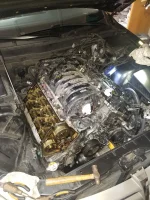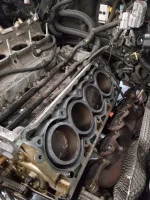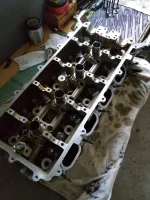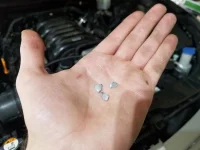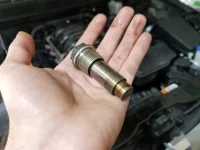rtrofimovich
Hasn't posted much yet...
- Joined
- Aug 21, 2015
- Messages
- 37
- Reaction score
- 15
- Points
- 8
Some background - 2012 Genesis 4.6. Started to develop a rattle/clacking sound ONLY on warm starts where after driving the car at operating temps, I would shut it off, and if I started it again anywhere from 5 minutes to an hour afterwards, it would rattle for a second or two after ignition (as the RPMs settled to idle). Research led me to the conclusion that a bad timing chain tensioner was the culprit. Being a bit lazy and also pretty busy, I let it slide to the back of my mind and ignored it for about 20,000 miles. One day, the startup rattle was more persistent, lasting until I got on the gas a bit (oil pressure builds up, voila). Later that day, the car shook violently on the start sequence and wouldn't start. I had it towed home and there began my journey of disappointment.
*All of this was done with the engine in the car and took about a month and a half - mostly waiting on parts because parts suppliers don't know how to count to 8*
Removed airbox, rad fan shroud, all serpentine belt components (AC pump is tough, need an offset wrench and gotta approach it from under and behind - Alternator requires dropping the bracket and pulling the alternator out the top), intake manifold, water pump, thermostat, all tubing, all wiring, valve covers, two upper timing covers, and finally the lower timing cover (requires a LOT of prying to break the RTV seal). Found that the left bank (right side when standing in front of the car looking at it) timing chain tensioner spring was seized and slid back and forth in the channel without any spring tension. Right bank timing chain tensioner was good, guides were good (absolutely no wear), no significant signs of wear anywhere on cams. Cool. So my dad, brother, and I got to setting the timing. Here is my first point of annoyance with Hyundai. The crankshaft timing mark is a small half moon cutout in the flex plate that sits between the end of the crank shaft and the crankshaft pulley.. Why Hyundai... Why... Next, apparently Hyundai thought it amusing to make the timing links on the timing chain the same color as oil... and also, all the other links just a slightly different shade of oil/metal... Why Hyundai... Why... They are very difficult to identify and make the whole process more tedious. Anyhow, we got the timing set. To install tensioners, you screw them into their respective banks (different threads make it impossible to mix the caps up), then you push the pivoting chain guide arm against the tensioner to fire it, and slowly let it out. Also replaced the oil pump chain tensioner because why not. Check all the timing marks again, then go for a couple test spins of the crank. We noticed some uneven resistance we thought was just spring pressure on the cams. But before we started to reassemble, we decided to do a compression test. Right bank all checked out, left bank had no compression anywhere... Turns out the clearance pistons Hyundai uses aren't REALLY clearance pistons. All 8 exhaust valves on the left bank had fought the pistons, and the pistons won. So we got to taking off the head (requires a Sunex 212MZB 12mm head bolt socket, $20 on Amazon - also requires insane patience as there is almost no clearance to remove the lower exhaust header nuts, requires an offset wrench). This is where I lost all faith in Hyundai as a manufacturer. When we got the head off and pulled the head gasket, we found metal shavings from machining stuck in a water channel in the block pressed against the edge of the gasket. Nice quality control Hyundai, nice... Knocked out all the bent exhaust valves from the head, installed new valves (took three weeks to get them all, first received only 7 of the 8 that I ordered), bedded them in, dropped the head back on the block, torqued that sucker down to the specs in the service manual, reset all the timing, checked compression, and was relieved to see everything pump up to normal. Assembly lube was applied all the friction areas of the head. Now, this car is not designed to service the timing system with the motor still in the car, because the reassembly process of the lower timing cover requires both the lower and upper oil pans to be off. This forced us to come up with some creative re-engineering (ask for details if you like) of the timing cover and the overhang of the head gasket to ensure good RTV seals. Everything was then reassembled per the service manual and fluids were added. Cranked the car over and it started up after about 15 seconds. A period of clatter followed for about 5 seconds, then it quieted down as oil flow built up into the heads. Slight lifter ticking was still heard for a bit but gradually went away. Idle is very stable and there are no weird shudders or hesitations. Got the car up to operating temps and everything seemed normal. Shut it down, waited 10 minutes, and started it up again only to hear the SAME RATTLE/CLACKING NOISE AS BEFORE... Currently researching the deepest parts of the internet for as much information as I can get on what can be causing warm start rattles that is not the timing chain tensioners... There's lots to this story I didn't include, feel free to ask if there are any questions.
But I've made up my mind... this is the first and LAST Hyundai I will own... and its a shame because I really did enjoy the Genesis while it was running well.
I attached a few photos of the process, including the failed tensioner and the metal shavings I found in the block.
TL;DR - Thought timing chain tensioner was causing rattle, timing chain tensioner killed my valves, fixed the whole left bank valve train and entire timing system only to have the car continue to rattle. Found reasons along the way to never buy another Hyundai.
*All of this was done with the engine in the car and took about a month and a half - mostly waiting on parts because parts suppliers don't know how to count to 8*
Removed airbox, rad fan shroud, all serpentine belt components (AC pump is tough, need an offset wrench and gotta approach it from under and behind - Alternator requires dropping the bracket and pulling the alternator out the top), intake manifold, water pump, thermostat, all tubing, all wiring, valve covers, two upper timing covers, and finally the lower timing cover (requires a LOT of prying to break the RTV seal). Found that the left bank (right side when standing in front of the car looking at it) timing chain tensioner spring was seized and slid back and forth in the channel without any spring tension. Right bank timing chain tensioner was good, guides were good (absolutely no wear), no significant signs of wear anywhere on cams. Cool. So my dad, brother, and I got to setting the timing. Here is my first point of annoyance with Hyundai. The crankshaft timing mark is a small half moon cutout in the flex plate that sits between the end of the crank shaft and the crankshaft pulley.. Why Hyundai... Why... Next, apparently Hyundai thought it amusing to make the timing links on the timing chain the same color as oil... and also, all the other links just a slightly different shade of oil/metal... Why Hyundai... Why... They are very difficult to identify and make the whole process more tedious. Anyhow, we got the timing set. To install tensioners, you screw them into their respective banks (different threads make it impossible to mix the caps up), then you push the pivoting chain guide arm against the tensioner to fire it, and slowly let it out. Also replaced the oil pump chain tensioner because why not. Check all the timing marks again, then go for a couple test spins of the crank. We noticed some uneven resistance we thought was just spring pressure on the cams. But before we started to reassemble, we decided to do a compression test. Right bank all checked out, left bank had no compression anywhere... Turns out the clearance pistons Hyundai uses aren't REALLY clearance pistons. All 8 exhaust valves on the left bank had fought the pistons, and the pistons won. So we got to taking off the head (requires a Sunex 212MZB 12mm head bolt socket, $20 on Amazon - also requires insane patience as there is almost no clearance to remove the lower exhaust header nuts, requires an offset wrench). This is where I lost all faith in Hyundai as a manufacturer. When we got the head off and pulled the head gasket, we found metal shavings from machining stuck in a water channel in the block pressed against the edge of the gasket. Nice quality control Hyundai, nice... Knocked out all the bent exhaust valves from the head, installed new valves (took three weeks to get them all, first received only 7 of the 8 that I ordered), bedded them in, dropped the head back on the block, torqued that sucker down to the specs in the service manual, reset all the timing, checked compression, and was relieved to see everything pump up to normal. Assembly lube was applied all the friction areas of the head. Now, this car is not designed to service the timing system with the motor still in the car, because the reassembly process of the lower timing cover requires both the lower and upper oil pans to be off. This forced us to come up with some creative re-engineering (ask for details if you like) of the timing cover and the overhang of the head gasket to ensure good RTV seals. Everything was then reassembled per the service manual and fluids were added. Cranked the car over and it started up after about 15 seconds. A period of clatter followed for about 5 seconds, then it quieted down as oil flow built up into the heads. Slight lifter ticking was still heard for a bit but gradually went away. Idle is very stable and there are no weird shudders or hesitations. Got the car up to operating temps and everything seemed normal. Shut it down, waited 10 minutes, and started it up again only to hear the SAME RATTLE/CLACKING NOISE AS BEFORE... Currently researching the deepest parts of the internet for as much information as I can get on what can be causing warm start rattles that is not the timing chain tensioners... There's lots to this story I didn't include, feel free to ask if there are any questions.
But I've made up my mind... this is the first and LAST Hyundai I will own... and its a shame because I really did enjoy the Genesis while it was running well.
I attached a few photos of the process, including the failed tensioner and the metal shavings I found in the block.
TL;DR - Thought timing chain tensioner was causing rattle, timing chain tensioner killed my valves, fixed the whole left bank valve train and entire timing system only to have the car continue to rattle. Found reasons along the way to never buy another Hyundai.



